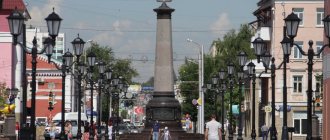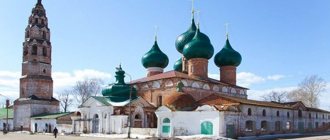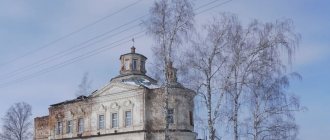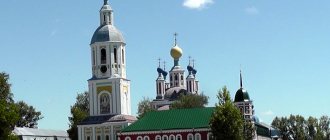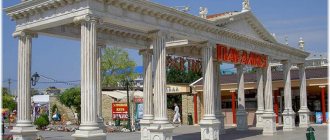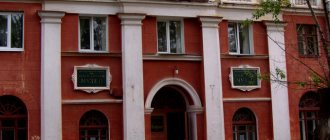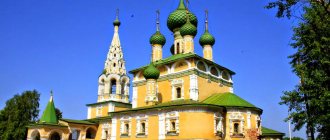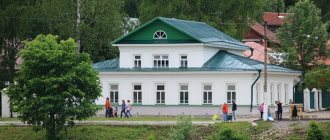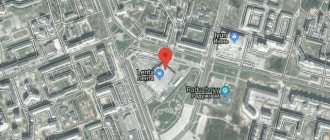Buzuluk is a city with an interesting history, which is located in the Orenburg region. The city was founded back in 1736. Initially, there was a Buzuluk fortress on this site, which in turn was built on the site of the ruins of an ancient Bashkir settlement.
The building of the former women's gymnasium is the most recognizable symbol of Buzuluk.
What is interesting is that this educational institution, although it provided knowledge of various contents, always provided secondary education.
Another recognizable symbol of the city is the water tower. Together with the building of the women's gymnasium, they represent a complete architectural ensemble in the pseudo-Gothic style.
In addition, museum visitors are attracted by: a unique collection of paintings by the artist Malyavin, a collection of ancient samovars and Sarmatian swords.
The main shrine of the monastery is the Tikhvin Icon of the Mother of God, which was transferred to the monastery from the Trinity-Sergius Lavra in 2001.
A unique landmark of the city is Buzuluksky Bor. It is located approximately 15 kilometers from the city, on the border of the Samara and Orenburg regions.
Ataman Mountain
Since the city is located in the foothills of the Urals, there are a fairly large number of hills. Some of them have become widely known because of their interesting history.
The building of the former real school
During the Great Patriotic War, evacuation hospital No. 1662 was located here. The architectural ensemble of the building is designed in the “Russian Renaissance” style.
According to urban legend, the building was built according to the design of captured Austrians, who, if they did good work, were promised freedom by their superiors. The building was built, so the prisoners were released, after which they were recorded dead and buried in the church.
Officially, the building was built under the leadership of the Austrian architect Chedra and contractor N.I. Lazarev.
In 1917, the first district congress of workers and peasants was held here; during the Patriotic War, the headquarters of Andersen’s Polish army was located here. Currently, the building houses the College of Industry and Transport.
In 2005, a memorial to Victory and Military Glory was opened in Buzuluk. The date of its opening was timed to coincide with the sixtieth anniversary of the Victory. The memorial itself consists of armored vehicles, military equipment and weapons from the Second World War displayed in Victory Square.
All presented specimens are museum exhibits. The location of the memorial is symbolic - opposite the Eternal Flame, the reconstruction of which was completed in the spring of 2015.
Music school building
Later, the building housed the headquarters of the twenty-fifth rifle division, commanded by V.I. Chapaev. Later in the house there were: the provincial executive committee, the irrigation and drainage technical school, and the hospital. Currently, in a building built in the “Russian Art Nouveau” style there is a music school.
On souvenir postcards with views of the city, you can often find his image. Graceful lines, strict turrets, luxurious window arches - all this combines the pseudo-Gothic style of the building. This ensemble was designed by architect Ian Adams in 1901. Initially, there was a women's gymnasium here, today there is a pedagogical school here.
The museum presents the archaeological and historical past of the region.
Currently the museum has the following exhibitions: the Interior of a Peasant Hut hall, the Foundation of the Fortress hall, the Nobility and Merchants hall, the Buzuluk and County halls 1900-1917, 1917-1920, 1921-1941, the Great Patriotic War hall, the Czechoslovak Army hall, the Nature hall , Space Hall, Socialism Hall.
The founder of the monastery is considered to be Evfemia Gerasimovna Ovsyannikova, who, in a relatively short time, transformed a small nunnery into the St. Tikhvin Mother of God Convent.
Buzuluksky pine forest
Buzuluksky Bor today is a national park, its territory is protected. It will be interesting for tourists to visit those located in this territory: the “steep bank” tract, the “eagle ridge” tract, a sphagnum bog, and an arboretum.
The Ataman Mountains are located 5 kilometers on the north side of the city. Even during the existence of the Buzuluk fortress, robber gangs lived here, who dug many caves and tunnels here to hide the loot and hide from retribution.
Now, on the site where the monastery used to be, there is the Church of the Icon of the Mother of God “Joy of All Who Sorrow” or the Temple on the Caves. The caves themselves today are the largest center of pilgrimage in the Orenburg region.
Monument to Internationalist Soldiers
Monuments to soldiers who gave their lives in local wars are located on the Alley of Friendship. The memorial was opened in 2008, on Border Guard Day. The material of the monument is black granite.
The building was built in 1913 by the merchant Podgornov, later it was bought by the merchant Stepan Kiselev, after which an additional third floor was added. At that time, he, his brother Nikolai and their families lived in the house.
The building of the former girls' gymnasium
The building of the former women's gymnasium is the most recognizable symbol of Buzuluk.
On souvenir postcards with views of the city, you can often find his image. Graceful lines, strict turrets, luxurious window arches - all this combines the pseudo-Gothic style of the building. This ensemble was designed by architect Ian Adams in 1901. Initially, there was a women's gymnasium here, today there is a pedagogical school here.
What is interesting is that this educational institution, although it provided knowledge of various contents, always provided secondary education.
Address: M. Gorky street - 59.
Music school building
The building was built in 1913 by the merchant Podgornov, later it was bought by the merchant Stepan Kiselev, after which an additional third floor was added. At that time, he, his brother Nikolai and their families lived in the house.
Later, the building housed the headquarters of the twenty-fifth rifle division, commanded by V.I. Chapaev. Later in the house there were: the provincial executive committee, the irrigation and drainage technical school, and the hospital. Currently, in a building built in the “Russian Art Nouveau” style there is a music school.
Source
Water tower
Another recognizable symbol of the city is the water tower. Together with the building of the women's gymnasium, they represent a complete architectural ensemble in the pseudo-Gothic style.
The buildings fit together so well because they were built by the same architect, Ian Adams.
The tower is superbly decorated, which allows, as far as possible, to hide its main functionality. When designing the tower, the architect made what is called a bet on appearance.
The need for a water tower for Buzuluk at the beginning of the 20th century is difficult to dispute, because the city at that time, almost entirely, with rare exceptions, was built up with wooden buildings that instantly caught fire.
To extinguish regularly occurring fires, it was decided to build a water tower; the merchant F.F. helped bring this decision to life. Krasikov, financing the project.
Address: Lenin street-67.
City Museum of Local Lore
In the center of the city, in a building of the Russian Art Nouveau architectural style, built by the merchant Podrezov at the beginning of the last century, there is a local history museum. The museum was founded in 1954 and is to this day the educational center of the Orenburg region in its West.
The museum presents the archaeological and historical past of the region.
Currently the museum has the following exhibitions: the Interior of a Peasant Hut hall, the Foundation of the Fortress hall, the Nobility and Merchants hall, the Buzuluk and County halls 1900-1917, 1917-1920, 1921-1941, the Great Patriotic War hall, the Czechoslovak Army hall, the Nature hall , Space Hall, Socialism Hall.
In this museum you can order a lecture on any topic and visit interesting exhibitions.
In addition, museum visitors are attracted by: a unique collection of paintings by the artist Malyavin, a collection of ancient samovars and Sarmatian swords.
Address: Lenin street-56.
TOP 9 Attractions of Buzuluk
Buzuluk is a city with an interesting history, which is located in the Orenburg region. The city was founded back in 1736. Initially, there was a Buzuluk fortress on this site, which in turn was built on the site of the ruins of an ancient Bashkir settlement.
Buzuluk received its name from the river of the same name, on which the fortress was located. From the ancient Turkic language Buzuluk is translated as ice. This name among the Turks characterized rivers fed by melting snow.
The building of the former girls' gymnasium
The building of the former women's gymnasium is the most recognizable symbol of Buzuluk.
On souvenir postcards with views of the city, you can often find his image. Graceful lines, strict turrets, luxurious window arches - all this combines the pseudo-Gothic style of the building. This ensemble was designed by architect Ian Adams in 1901. Initially, there was a women's gymnasium here, today there is a pedagogical school here.
What is interesting is that this educational institution, although it provided knowledge of various contents, always provided secondary education.
Address: M. Gorky street - 59.
Water tower
Another recognizable symbol of the city is the water tower. Together with the building of the women's gymnasium, they represent a complete architectural ensemble in the pseudo-Gothic style.
The buildings fit together so well because they were built by the same architect, Ian Adams.
The tower is superbly decorated, which allows, as far as possible, to hide its main functionality. When designing the tower, the architect made what is called a bet on appearance.
To extinguish regularly occurring fires, it was decided to build a water tower; the merchant F.F. helped bring this decision to life. Krasikov, financing the project.
Address: Lenin street-67.
City Museum of Local Lore
Mansion from the beginning of the 20th century. Now there is a local history museum here. On the facade of the building is the coat of arms of Buzuluk.
This is what the first coat of arms of Buzuluk looked like in 1782: “At the top of the shield is the coat of arms of Ufa. At the bottom there is a silver deer in a green field, meaning that this country is abundant in these animals.” On the modern coat of arms of the city (1998), only a silver deer standing on golden ground remains in a green field. The museum presents the archaeological and historical past of the region.
Currently the museum has the following exhibitions: the Interior of a Peasant Hut hall, the Foundation of the Fortress hall, the Nobility and Merchants hall, the Buzuluk and County halls 1900-1917, 1917-1920, 1921-1941, the Great Patriotic War hall, the Czechoslovak Army hall, the Nature hall , Space Hall, Socialism Hall.
In this museum you can order a lecture on any topic and visit interesting exhibitions.
In addition, museum visitors are attracted by: a unique collection of paintings by the artist Malyavin, a collection of ancient samovars and Sarmatian swords.
Address: st. Lenina, 56. Visitors are welcome from 9 a.m. to 5 p.m. on any day except Monday.
Men's real school.
The men's real school was built in 1911, its first director was Guriy Matveevich Vishnevsky.
Later, during Soviet times, the building was occupied by a secondary school named after A.S. Pushkin. In addition, there is a memorial plaque on the building with the name of the poet, on which it is written that A.S. Pushkin visited this place while collecting information about the Pugachev peasant uprising for his work “The Captain's Daughter.”
During the Great Patriotic War, evacuation hospital No. 1662 was located here. The architectural ensemble of the building is designed in the “Russian Renaissance” style.
St. Tikhvin Convent
The history of the most ancient monastery in Buzuluk is interesting. The first in the entire Orenburg region was erected the St. Tikhvin Convent in 1857.
The founder of the monastery is considered to be Evfemia Gerasimovna Ovsyannikova, who, in a relatively short time, transformed a small nunnery into the St. Tikhvin Mother of God Convent.
During the years of Soviet power, the monastery was plundered and did not function for a long time. But now the convent has fully acquired its rights and functions.
The main shrine of the monastery is the Tikhvin Icon of the Mother of God, which was transferred to the monastery from the Trinity-Sergius Lavra in 2001.
Address: Sergo street-1A.
The building of the former Zemstvo Government
According to urban legend, the building was built according to the design of captured Austrians, who, if they did good work, were promised freedom by their superiors. The building was built, so the prisoners were released, after which they were recorded dead and buried in the church.
Officially, the building was built under the leadership of the Austrian architect Chedra and contractor N.I. Lazarev.
In 1917, the first district congress of workers and peasants was held here; during the Patriotic War, the headquarters of Andersen’s Polish army was located here. Currently, the building houses the College of Industry and Transport.
Address: 1 May Street - 35.
Cathedral of St. Nicholas the Wonderworker
The second place in historical antiquity in the city after the convent is occupied by the Cathedral of St. Nicholas the Wonderworker. In 1908-1910, a church was built near the city's railway station. It had a tented bell tower and a common basilica building. But, with the advent of Soviet power, it was converted into a sports school and closed in 1929. In the 1990s it was returned to believers and renovated.
Address: 1st line street - 57.
Music school building
The building was built in 1913 by the merchant Podgornov, later it was bought by the merchant Stepan Kiselev, after which an additional third floor was added. At that time, he, his brother Nikolai and their families lived in the house.
Later, the building housed the headquarters of the twenty-fifth rifle division, commanded by V.I. Chapaev. Later in the house there were: the provincial executive committee, the irrigation and drainage technical school, and the hospital. Currently, in a building built in the “Russian Art Nouveau” style there is a music school.
Address: Otakar Yarosha street - 45.
The only example of Stalina discovered in Buzuluk. An interesting rare bas-relief in the form of the coat of arms of the RSFSR.
The building of the Central District Hospital, built in 1957, at the intersection of Rozhkov and Pushkin streets.
Share:
St. Tikhvin Convent
The history of the most ancient monastery in Buzuluk is interesting. The first in the entire Orenburg region was erected the St. Tikhvin Convent in 1857 .
The founder of the monastery is considered to be Evfemia Gerasimovna Ovsyannikova, who, in a relatively short time, transformed a small nunnery into the St. Tikhvin Mother of God Convent.
During the years of Soviet power, the monastery was plundered and did not function for a long time. But now the convent has fully acquired its rights and functions.
The main shrine of the monastery is the Tikhvin Icon of the Mother of God, which was transferred to the monastery from the Trinity-Sergius Lavra in 2001.
Address: Sergo street-1A.
Attractions in Buzuluk
Russia, Orenburg region, Buzuluk district, Buzuluk
Buzuluksky Bor is a unique natural monument and a heritage of the entire Orenburg region; it is located not far from the city of Buzuluk. The dimensions of the Buzuluksky pine forest are amazing, the total length is about 50 kilometers, and the width is about 30
Sights of Buzuluk
Interesting places
A gorge in the Kislovodsk region through which the Berezovka River flows. ›››
Tour blog
Hiking to the top of Mount Beshtau is a favorite type of active recreation for many tourists on the CMS, and winter walks are no exception. ›››
News
“Arkhyz” is a real pearl of the Caucasus. Since the end of 2013, the ski village has been able to receive about 1,000 tourists daily. The resort is accessible all year round, but is not recommended here in winter. ›››
Special offers
Vouchers to the Lenina sanatorium in the Republic of Belarus at low prices. Excellent location on the river bank in the city of Bobruisk Belarus. Convenient transport links. There are big discounts and promotions for the 1st quarter. ›››
Reviews and comments
Everything is very cool)) We went with the whole family, initially just to relax and leave the bustling city. When we went...
Guys, I am very pleased with my trip to Goryachy Klyuch! Without expecting it, I fell under the spell...
We went on vacation as a family with two small children. Everyone was happy. Well-groomed area, private beach, good…
Buzuluksky pine forest
A unique landmark of the city is Buzuluksky Bor. It is located approximately 15 kilometers from the city, on the border of the Samara and Orenburg regions.
The Buzuluk forest mainly consists of pine trees, but in some places there are also deciduous trees, the latter usually growing along the Borovka River. The forest is located in the steppes of the Trans-Urals, its history begins with the last ice age.
Currently, this is where the oldest pine tree in Russia is located; it is approximately 350 years old. Interestingly, this place is home to animals and birds currently listed in the Red Book: peregrine falcon, bustard, white-tailed eagle, little bustard, lapwing, and muskrat.
Buzuluksky Bor today is a national park, its territory is protected. It will be interesting for tourists to visit those located in this territory: the “steep bank” tract, the “eagle ridge” tract, a sphagnum bog, and an arboretum.
Buzuluk
The oldest city in the Orenburg region arose as a nondescript temporary fortress, but has been developing and growing for almost 300 years. The city was built on the spot where the Buzuluk River flows into the Samara tributary of the Volga. It was captured by participants in the Pugachev uprising, Kolchak’s army, and Chapaev’s division. According to historians, A.S. Pushkin stayed here and wrote down the history of the last battle of the Pugachevites. The place where the poet visited is now a hotel.
2 things worth doing in Buzuluk:
- Capture a photo of the noctule - a giant bat with a wingspan of up to 40 cm, which is found in the Orenburg region only in the Buzuluksky forest.
- Visit the grave of the schema-monk Maxim in the old cemetery of the Church of All Saints.
Exclusive routes for individual groups. Excursions around Kazan, Sviyazhsk, Bolgar, Yoshkar-Ola, etc. Participation in “Sabantuy” and master classes.
Accreditation, excellent reviews, excursions in English, Russian and Tatar.
“Kazan at 15:15” is part of the international project of useful excursions “Tours at 15:15”. Join the best sightseeing tour of Kazan to explore the city!
We meet every day at 15:15!
Accreditation, extensive experience, excellent reviews, in Russian and English, groups of any size.
I will provide comfortable transport
“The Subtleties of Tourism” recommends City Bus - daily bus excursions around Kazan with visits to the Kremlin, the Kul-Sharif Mosque, Raifa, and the Temple of All Religions. Weekend tours in Tatarstan. And also the famous red double-decker Hop-On Hop-Off bus. Online tickets from 500 rub.
Diveevskaya Sloboda is a 4 star hotel. Convenient location close to all the main attractions of the village. Diveevo. Cozy eco-friendly wooden rooms, international level of service.
Welcome to the atmosphere of Russian hospitality!
How to get there
The most economical way to get from Orenburg to Buzuluk is the Orenburg - Samara train. From Samara you need to go to Koltubanka station.
The morning train Orenburg - Buzuluk runs to the Buzuluksky pine forest. At the Buzuluk station you need to find a bus going to Panika, or you can use a taxi, which is much faster.
Search for air tickets to Orenburg (the nearest airport to Buzuluk)
Popular hotels in Buzuluk
Book popular Buzuluk hotels at the best prices
Entertainment and attractions of Buzuluk
Nature
Buzuluksky pine forest is a huge forest in the shape of a triangle. It seems to be cut by the pattern of the Borovka River, which flows into Samara. The entire right bank is dotted with oxbow lakes and streams with beaver dams. In the coniferous forest grow red geraniums, soft purple bells, patterned ferns, melt-in-your-mouth blackberries, mosses and lichens.
Fishermen often come to Borovka: here they come across ide, burbot, char, bystryanka, and brook trout.
Buzuluksky Bor has its own attractions, for example, the marshy sphagnum bog Losinaya Pristan, which is completely overgrown with sphagnum moss and cotton grass. In the Partizansky forestry there is a unique reed swamp, Crane Guy, where the gray crane lives. And to the north of the Chertalyk cordon stretches the Steep Bank tract, steep and picturesque.
Getting to the forest is quite simple: take a taxi or take a gazelle to the Partizansky Village stop.
Weather in Buzuluk
Architecture of Buzuluk
The building of the women's gymnasium, built in the pseudo-Gothic style with characteristic turrets, lancet windows and doors, is considered a cultural monument. One of the central walking streets, Friendship Alley, is topped with a monument to internationalist soldiers who died in Afghanistan and soldiers who gave their lives in local wars. Another patriotic monument is the Victory and Military Glory Memorial, erected in honor of the 60th anniversary of the victory in the Great Patriotic War of 1941-1945.
The buildings of the music school, the children's clinic (the former merchant mansion of the Kiselev family), the zemstvo government (now the College of Industry and Transport), and the former men's real school (now school No. 6) are built in a rare Russian Art Nouveau style.
It is worth looking into the cave monastery of the Transfiguration Monastery, which was visited by Leo Tolstoy. During the years of Soviet power, the monastery was closed, then it was restored and cleared for a long time, and was opened quite recently - in May 2022. An hour's drive from Buzuluk is the village of Derzhavin, where the ancient church of the family of the poet G. R. Derzhavin is well preserved.
Museum of Local Lore
The old mansion houses the city's local history museum, where paintings by the artist Malyavin, a collection of samovars and Sarmatian swords are kept. Address: st. Lenina, 56. To get to it, you need to take shuttle buses No. 1, 7, 8 at the station and go to the Leninskaya stop. The museum is open daily from 9:00 to 17:00, except Mondays.
Ataman Mountain
Since the city is located in the foothills of the Urals, there are a fairly large number of hills. Some of them have become widely known because of their interesting history.
The Ataman Mountains are located 5 kilometers on the north side of the city. Even during the existence of the Buzuluk fortress, robber gangs lived here, who dug many caves and tunnels here to hide the loot and hide from retribution.
At the beginning of the 19th century, the bandits left this place, hermits and future monks came here. These people dug additional caves as cells, and later the largest Spaso-Preobrazhensky monastery was erected in these places.
Now, on the site where the monastery used to be, there is the Church of the Icon of the Mother of God “Joy of All Who Sorrow” or the Temple on the Caves. The caves themselves today are the largest center of pilgrimage in the Orenburg region.
Seven wonders of Buzuluk region
The Buzuluk district and the city of Buzuluk are a natural, historical and cultural reserve of the Orenburg region. We invite you to plunge into its rich history
Natural parks and ancient cities, Orthodox shrines, places where Gabriel Derzhavin, Nikolai Karamzin and Vladimir Vysotsky lived. What else is the fertile Orenburg land proud of?
Buzuluksky Bor National Park
The Buzuluksky Bor National Park is considered the green pearl of the Orenburg region. Its age is 6–7 thousand years. The main attractions of the forest are pine trees aged 350–380 years and picturesque natural landscapes.
The Buzuluk Museum displays more than 20 thousand exhibits.
All conditions have been created for tourists: recreation centers operate, various routes have been developed, and excursions are conducted. The Pine House, a specialized information center, recently opened. Children will be especially interested here: there is a separate educational and play area for them.
Clean air that makes your head spin, the aroma of pine needles, centuries-old pine trees... Holidays in the Buzuluksky forest are a real fairy tale!
In addition to rare icons, the Mother of God Convent contains other shrines.
How to get there
Buzuluksky pine forest is located on the border of the Orenburg and Samara regions, 15 kilometers from the city of Buzuluk. You can get there by car from Orenburg to the village of Partizansky. You can also take trains running between Orenburg and Samara to the Koltubanovsky station. You can stay at the Buzuluksky Bor sanatorium, at the Sosny or Riviera recreation centers.
Architecture and monuments of Buzuluk
The city of Buzuluk was founded in 1736 by the leader of the Orenburg expedition, Ivan Kirilov.
The first Buzuluk landowners were the Derzhavins, Karamzins, Lyakhovs and Strakhovs. The city was visited by Alexander Pushkin, who collected materials in the Orenburg region for “The History of the Pugachev Rebellion” and “The Captain’s Daughter”, Emperors Alexander I, Alexander II and Nicholas II. Buzuluk is also mentioned in Dmitry Furmanov’s cult novel “Chapaev”, dedicated to the events of the Civil War.
The collection of the Buzuluk Local Lore Museum contains many different household items, ethnography and photographic documents.
The city of Buzuluk is also interesting because it has preserved a valuable layout, stone and wooden buildings, and individual architectural monuments of the second half of the 19th – early 20th centuries. Scientists and travelers call Buzuluk a reserve of wooden modernism, a wonderful example of a county town.
Once in the city, be sure to visit the Buzuluk Local Lore Museum. Valuable paleontological, archaeological and historical exhibits are exhibited here, as well as original works by the world famous artist Philip Malyavin, who was born in Buzuluk district.
One of the main attractions of the Urals is Buzuluksky Bor.
While studying the wooden buildings of Buzuluk, Pavel Gnilorybov found 3 September Street in the city, was inspired by Shufutinsky’s song and came up with Shufutinsky’s day. Creative townspeople picked up the idea and started a new tradition. It was decided to plant an alley of rowan trees on 3 September Street, and Mikhail Shufutinsky himself has already promised to come to Buzuluk.
How to get there
One of the most economical ways to get from Orenburg to Buzuluk is by train. Travel time is about five hours. You can also get to Buzuluk by private car along the P224 Orenburg – Samara highway. Travel time is about three hours.
In the city you can stay in the hotels “Park Hotel Pushkin” and “Buzuluk”.
Shrines of the Tikhvin Mother of God Monastery
The Buzuluk Tikhvin Mother of God Convent was founded in 1847 by a native of the Tambov province, Evfemia Ovsyannikova. By the 1890s, a large architectural complex consisting of several cathedrals and temples, household and utility buildings was erected in the monastery.
The main shrines of the monastery are a list of the miraculous Tikhvin Icon of the Mother of God, which was preserved in the 20th century, and an icon of St. Seraphim of Sarov with a particle of the relics of the ascetic.
The caves of the Buzuluk Spaso-Preobrazhensky Monastery have existed since the end of the 19th century.
After the revolution, the monastery was closed.
The revival of the monastery began at the turn of the 20th–21st centuries with the Church of All Saints, which is one of the most important attractions of Buzuluk. The historical territory was returned to the monastery, where work is now underway to restore the architectural complex.
How to get there
The Mother of God Convent is located at the address: Buzuluk, st. Sergo, 1.
Caves of the Spaso-Preobrazhensky Monastery
The opening of the monastery, approved by Emperor Nicholas I and the Holy Synod, took place in 1853 and became an important event in the history of the Samara Trans-Volga region and the Southern Urals.
In 1903, the temple of the icon of the Mother of God “Joy of All Who Sorrow” was built on the caves. The caves themselves are underground corridors and cells where ascetics lived. In 1873, they were visited by the great Russian writer Leo Tolstoy, who communicated with the elders.
The oldest of the churches in the Orenburg region is the Orthodox church in the village of Derzhavino.
The main shrine of the monastery was a copy of the miraculous icon of the Mother of God “Joy of All Who Sorrow.” This image became famous for healing the sick and was loved by the people. Today, the holy caves of the Spaso-Preobrazhensky Monastery are one of the most visited tourist and pilgrimage places in the Orenburg region.
How to get there
The temple on the caves is located 3 kilometers from the city of Buzuluk in the village of VTK, no. 7.
Temple built by Derzhavin
In the Orenburg region, the Orthodox Church of the Smolensk Icon of the Mother of God has been preserved, which was erected through the efforts of the poet Gabriel Derzhavin. The poet himself has been here several times. Derzhavino is called the literary crossroads of Russia, since the history of the village and the temple is directly connected with the Aksakovs, Karamzins, Shishkovs, Nabokovs, and the poet Evgeny Kurdakov.
The birthplace of Nikolai Karamzin is the village of Preobrazhenka (formerly the village of Mikhailovka).
The monumental painting of the temple has historical and artistic value. Experts believe that the famous paintings of the Vladimir Cathedral in Kyiv became an example for the Derzhavinsky temple. Particular attention is drawn to the image of the Most Holy Theotokos with the Child of God in her arms. There is a monument to Gabriel Derzhavin in the rural park.
How to get there
The village of Derzhavino is located 64 kilometers from Buzuluk. You need to drive towards Buguruslan along the highway until you turn to the village.
Small homeland of Karamzin
The village of Preobrazhenka is the Orenburg estate of the Karamzin family. Before the revolution it was also called Mikhailovka and Karamzikha. Founded in the 1750s by the historiographer’s father, Mikhail Yegorovich, who received lands near Buzuluk for military service. According to many scientists, Nikolai Karamzin, a writer and author of “History of the Russian State,” was born directly in this village.
Preobrazhenka was the center of the provincial family and economic life of the Karamzins in the Orenburg region. To this day, in the historical part of the village, along with the temple-tomb of the Karamzins, part of the linden alley in the master's garden has been preserved. These objects, together with the monument to Nikolai Karamzin in the modern park and natural landscapes, are the main attractions of the village.
How to get there
The easiest way to get to the village of Preobrazhenka is by car, the distance from Buzuluk is 50 kilometers.
Vladimir Vysotsky lived here
The village of Vorontsovka received its name from the surnames of the Vorontsov nobles, who moved to the Orenburg region from the Simbirsk province. The remains of the mansion from that era remain as a legacy. In 1941–1943, the future poet, musician and actor Vladimir Vysotsky lived in evacuation in the village along with his mother Nina Vysotskaya.
The V. Vysotsky Museum in Vorontsovka was restored for the 80th anniversary of the poet.
The poet’s mother spent most of her time at work, so Volodya lived in kindergarten, and only on weekends did Nina Maksimovna take him home.
Marina Vladi, in her book about Vladimir Vysotsky, will write about how the famous Soviet poet warmly recalled his stay in Vorontsovka.
How to get there
The village of Vorontsovka is located 25 kilometers from Buzuluk. The easiest way to get there is by car. Departure from Buzuluk along O. Yarosha Street towards Buguruslan, then along the highway until the turn to the villages of Elkhovka and Vorontsovka.
Thematic excursions can be purchased at the Buzuluk Local History Museum at the address: Buzuluk, st. Lenina, 56, tel. 8 (353-42) 2-19-81, and at the Charitable Foundation named after. G.R. Derzhavina, tel..
Daria Ivanova
Monument to Internationalist Soldiers
Monuments to soldiers who gave their lives in local wars are located on the Alley of Friendship. The memorial was opened in 2008, on Border Guard Day. The material of the monument is black granite.
The composition in memory of the fallen soldiers is made in the form of a black slab with a photographic image of a soldier. Currently, the monument is quite famous; flowers are laid at it.
Address: Friendship Alley.
The building of the former real school
The men's real school was built in 1911, its first director was Guriy Matveevich Vishnevsky.
Later, during Soviet times, the building was occupied by a secondary school named after A.S. Pushkin. In addition, there is a memorial plaque on the building with the name of the poet, on which it is written that A.S. Pushkin visited this place while collecting information about the Pugachev peasant uprising for his work “The Captain's Daughter.”
During the Great Patriotic War, evacuation hospital No. 1662 was located here. The architectural ensemble of the building is designed in the “Russian Renaissance” style.
boris_mavlyutov
Boris Mavlyutov
Buzuluk. Bike ride around the city. Architecture. Attractions. 2013
Buzuluk was founded in 1736 as a fortress of the same name at the confluence of the Buzuluk River and the Samara River. In 1781, Buzuluk district was formed. The city has a rich history. He must remember the Pugachev uprising, the Cossacks of Ataman Dutov, Kolchak’s army, Chapaev’s division. During the Great Patriotic War, it formed the First Separate Czechoslovak Battalion (fought on the Soviet-German front and later grew into an army corps) and the Polish Army of General Anders (went to the Middle East with the support of the United States and England, then fought as part of the British Armed Forces strength). Currently, the city is part of the Russian oil and gas complex. The train from Orenburg arrived at the station early in the morning, so we had to spend some time in the waiting room. It immediately caught my eye that the guards behaved somehow unusually, not in a Russian way. People passing through the frames were searched when a signal appeared. They were not allowed to drink alcohol or behave loudly and provocatively. When it was time to go to the toilet, I showed the ticket with which I arrived here, so as not to pay the entrance fee. The attendant took out a magazine and said: “Please tell me your last name.” I was a little taken aback, but quickly came to my senses. - Abramovich. She, without any reaction, wrote it down and said: “Come on in.” At the same time, it was clear that she did not finish the phrase she was about to say. Probably, at the last moment I decided not to add “Roman Arkadyevich”, not being one hundred percent sure that it was him. After finishing my morning exercise, I was ready to meet Buzuluk. But he wasn’t there yet, so the church standing next to the station had to be passed without stopping due to insufficient lighting. The nearby school building was also in darkness. But next to it were the lines of one of the best war poems. The famous phrase was cut off, apparently due to avoiding an unnecessary reminder about smoking near the school. And I will allow myself to finish it." without finishing the last cigarette. »
Reminder about Chernobyl.
Tikhvin Convent. Mid-19th century.
Three divisions were created from the city residents. 11 thousand people did not return from the front (in 1939 the population of Buzuluk was 42 thousand inhabitants). Victory Memorial.
This part of the city turned out to be low. Lots of wooden houses. There are some interesting ones.
Synagogue. Because It was too early, there was no one to ask whether it was working or not.
Some of them are occupied by serious institutions. Kindergarten.
Sculpture in the fountain of a small square.
College of Education. The headquarters of the Czechoslovak battalion was located here.
College of Industry and Transport. This building housed the headquarters of the Polish army. And it was built for the zemstvo government in 1917.
LDPR branch on the first floor. I wonder what will happen to this party when its founding father passes away?
The restored Peter and Paul Church.
He's from a different angle.
Not quite a familiar monument for Russia. They had already desecrated him and resented his presence here. Next to it is a sign “Do not desecrate, do not litter, do not wash.” The latter could be excluded. If anyone doesn’t know, let me remind you that the Hungarians fought on Hitler’s side. (However, like the “brothers” Bulgarians).
An interesting building of a girls' gymnasium built in 1901. During the Civil War, it housed the headquarters of the Southern Group of Forces of the Eastern Front under the command of M. V. Frunze. Currently belongs to the College of Education.
Water tower (1905).
The new house has put on a tall cap.
Vladimir Ilyich looks like a man who has just released a bird. Maybe in vain? Better a bird in the hand than a pie in the sky.
See also: Park Switzerland in Nizhny Novgorod how to get there
The former real school became the school named after. A. S. Pushkin (1909).
Here he is too.
A little more of the old city.
And a new shopping center.
The store of merchant Kiselyov (late 19th century) became the Central department store.
House of the merchant Kiselyov. Beginning of the 20th century. During the Civil War, it housed the headquarters of V.I. Chapaev’s division.
The local history museum is located in the house of the merchant Podrezov (early 20th century).
Shop of merchant Khokhlov (early 20th century).
The local distillery appears to be closed. “What was the quality of the products?” I asked one local resident, whose appearance allowed us to consider him an expert in this matter. — It was excellent vodka. Until the new director arrived.
We continue to move along the old part.
A beautiful building near the hospital.
Cafe "Old Mill".
Twice Hero of the Soviet Union, USSR pilot-cosmonaut Yu. V. Romanenko was born near Buzuluk.
Vasily Ivanovich Chapaev. An excellent monument to the hero of the Civil War and the anecdotes that appeared later.
We cross the railway and find ourselves in a new area. Monument to soldiers who died in hot spots. Let's look at it from both sides.
The girl with the dove is somewhere there.
In Buzuluk you can see containers for collecting disposable tableware. What is right. We must try to find a solution to this important issue.
Let's remember old Europe.
We are again near the train station. Now you can take a closer look at the temple, which was hard to see in the dark in the morning. This is St. Nicholas Cathedral. He looks fit and slender. Not least because during Soviet times it housed a sports school. We had to wait at the station for the train to depart. The fatigue that had accumulated over the previous days, coupled with lack of sleep, made itself felt, and I began to nod off. I woke up when one of the security or police officers lightly pushed me on the shoulder: “Don’t sleep.” After some time I fell asleep again. And again I heard: “Don’t sleep.” My first thought was to publicly evaluate the actions of this employee, but something stopped me. After some time, I realized that I had finally found myself in a Russian city, where law enforcement officers were carrying out official instructions, albeit incorrect from the point of view of the passenger, and most likely the law. This discovery greatly inspired me, and the dream passed.
The building of the former Zemstvo Government
According to urban legend, the building was built according to the design of captured Austrians, who, if they did good work, were promised freedom by their superiors. The building was built, so the prisoners were released, after which they were recorded dead and buried in the church.
Officially, the building was built under the leadership of the Austrian architect Chedra and contractor N.I. Lazarev.
In 1917, the first district congress of workers and peasants was held here; during the Patriotic War, the headquarters of Andersen’s Polish army was located here. Currently, the building houses the College of Industry and Transport.
Address: 1 May Street - 35.
Buzuluk in old and modern photographs
Buzuluk was founded in 1736 as a fortress on the Orenburg Line. As a fortress, the current Buzuluk existed until 1781, when Catherine II gave it the status of a city. Since 1851, Buzuluk became part of the formed Samara province. The city returned to the Orenburg region only in 1934.
Tikhvin nunnery. Early 20th century.
Nowadays.
Market Square (in the foreground), Trinity Cathedral and the water tower (in the background). Trinity Cathedral was built in 1839-1847; in 1932-1941 it was demolished in several stages. The main trade of the city was carried out on the market square; there were shops of Kryukov, Kulyukin, Tatarintsev, Gumyansky and others. Now on the site of the shopping arcades there is Leninsky Square.
Nowadays the area of the former Market Square.
Shchepnaya Square, A. Nevsky Temple (in the background). Subsequently, the plant named after them was located here. Kuibysheva
Completely unexpected for the steppe district of Buzuluk is the so-called “house with the stars of David”, formerly a synagogue or a doctor’s house. The intersection of Oktyabrskaya and O. Yarosha streets. I didn’t know before that this town had its own synagogue.
My relatives live literally a few houses away from him. This house has been preserved almost the same as it was 100 years ago. And not all local residents know that there was a synagogue in Enem. Even the “stars of David” have been preserved.
Zemstvo government building. According to urban legend, the building was built according to the design of captured Austrians, for which the head of the city promised them freedom. At the end of construction, he kept his word: the Austrians were recorded as dead and staged a fake funeral service, and then sent home. In 1917, the first district congress of the Soviets of Workers', Peasants' and Soldiers' Deputies was held here. During the Great Patriotic War, the building housed the headquarters of the Polish army of Anders
This building now houses the Industrial and Pedagogical College (technical school)
Buzuluk railway station
Steam locomotives released from repairs on May Day. Buzuluk depot, 1931
The building of the Central District Hospital, built in 1957, at the intersection of Rozhkov and Pushkin streets
Factory warehouse in Buzuluk, 1895-1905
Crossroads st. May 1st - Lenin St. The first bus in Buzuluk 1930
The theater was located on what is now Kirova Street.
Holy Trinity Convent, 1900-1910s
Czechoslovak soldiers, 1942. St. Oktyabrskaya
Hotel "Metropol". Located on the street that now bears the name of Lenin
City Museum of Local Lore
The girls' gymnasium building was built in 1902 by architect Jan Adamson. The gymnasium was all-class and provided secondary education with eight years of study (the seventh grade was then divided into two years). In March–April 1919, the building housed the headquarters of the Turkestan Army, commanded by G.V. Zinoviev. In 1937, a pedagogical college moved into the building, later reorganized into the Buzuluk Pedagogical School
The water tower was built in 1905, also designed by Jan Adamson
Bird's eye view of the city center
Buzuluk Pedagogical College. In 1942-1943, the building housed the headquarters of the 1st Czechoslovak Separate Battalion
The Spaso-Preobrazhensky Monastery, restored in 2007, and the entrance to the caves below it. The monastery was opened in 1853. In the summer of 1875, Leo Tolstoy visited him. The monastery was abolished in 1929. After its closure, a commune and then a colony for street children were opened on its territory.
The Buzuluk Music College is located in the mansion of the merchant Podgorny. The mansion was built in 1913. Subsequently, it was acquired by the merchant G.M. Kiselev for his eldest son Stepan. In 1919, the headquarters of the Chapaev division was located there.
Yarosha Street, view of the city local history museum. On the first coat of arms of the city in 1782, the upper part of the shield depicted the Ufa coat of arms, and the lower part a silver deer in a green field, “meaning that this country is abundant in these animals.” On the modern coat of arms of the city in 1998, only a silver deer remains, standing on golden ground in a green field
The building of the men's real school, built in 1911. The first director was Guriy Matveevich Vishnevsky. During the years of Soviet power, schools No. 3 and 6 were located, during the Second World War - evacuation hospital No. 1662
photos taken: https://orenpolit.ru/dose/item/2440-staryj-i-novyj-buzuluk-v-fotografiyakh
https://vk.com/album-34306013_153112512
bridge over the Samarka river
Buzuluk car park 30s
The city has a rich history. For example, in 1942, the 1st Czechoslovak Infantry Battalion began to be created (Lieutenant Colonel L. Svoboda). On September 27, 1941, a military treaty was signed between the USSR and the government of Czechoslovakia, according to which the formation of a Czechoslovak infantry battalion began on the territory of the USSR. The formation of the battalion began on January 5, 1942 in Buzuluk, where 93 Czechoslovak military personnel who remained in the USSR were transferred [1]. The first commander of the battalion was Ludwik Svoboda. The battalion's personnel were equipped with British uniforms (which had previously been supplied to the Polish units of the army of Wladyslaw Anders) with insignia of the army of pre-war Czechoslovakia. In January 1942, the battalion was armed with Soviet small arms (SVTi Mosin rifles, pistols- PPSh machine guns, TT pistols and Nagan revolvers), as well as DP-27 light machine guns, Maxim heavy machine guns, PTRS anti-tank rifles and mortars (previously, soldiers practiced combat techniques on wooden weapon models). In July 1942, the formation of the battalion staff was completed , and on August 28, 1942 L. Svoboda wrote a letter to I.V. Stalin with a request to send the battalion to the front[4]. In October 1942, the battalion was fully equipped with standard weapons[4], including 50-mm and 82-mm mortars. At the beginning of 1943, the battalion's soldiers began collecting funds for the construction of tanks for the Red Army, as a result, by February 11, 1943, they collected 100 thousand rubles. With this money, two tanks were built (“Lidice” and “Lezhaki”), named after villages in Czechoslovakia destroyed by the Nazi occupiers [5] On January 30, 1943, the Czechoslovak battalion took the military oath. At this moment, the battalion's strength was 974 military personnel, including 26 officers, 10 captains, 237 non-commissioned officers and 663 privates. In addition to the Czechs and Slovaks, there were six Rusyns and Jews among the military personnel.
Cathedral of St. Nicholas the Wonderworker
The second place in historical antiquity in the city after the convent is occupied by the Cathedral of St. Nicholas the Wonderworker. In 1908-1910, a church was built near the city's railway station. It had a tented bell tower and a common basilica building. But, with the advent of Soviet power, it was converted into a sports school and closed in 1929.
In the 90s, believers turned to the authorities with a request to open a church, their request was fulfilled. In 2011, the church was given the status of a cathedral; today it is open and fully functioning.
Address: 1st line street - 57.
Memorial of Victory and Military Glory
In 2005, a memorial to Victory and Military Glory was opened in Buzuluk. The date of its opening was timed to coincide with the sixtieth anniversary of the Victory. The memorial itself consists of armored vehicles, military equipment and weapons from the Second World War displayed in Victory Square.
All presented specimens are museum exhibits. The location of the memorial is symbolic - opposite the Eternal Flame, the reconstruction of which was completed in the spring of 2015.
Address: Oktyabrskaya street.
